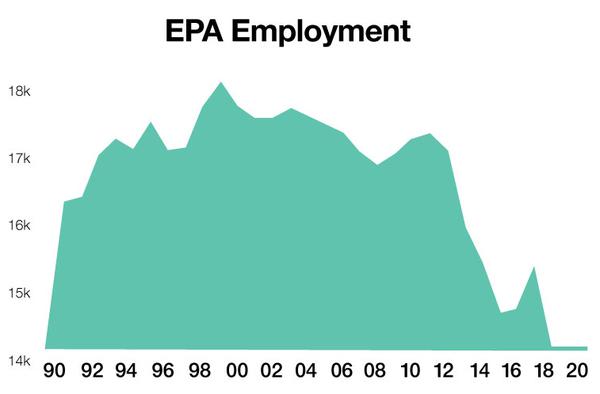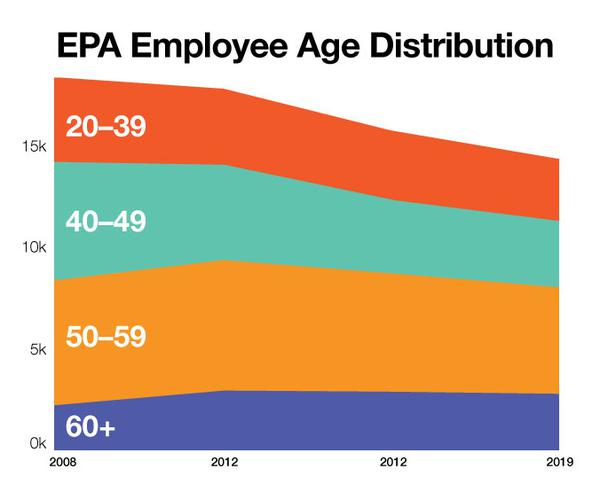Read article on the original site.
The wildfires and hurricanes plaguing the United States in the last month reflect the massive societal implications of climate change. Understanding the importance of this moment, Vice President Joe Biden has proposed a $2 trillion climate plan designed to transition the economy away from greenhouse gas emissions. The plan calls for an emission-free power sector by 2030, as well as an environmental justice component to address how climate policies have failed communities of color. Parts of Biden’s plan will require new legislation and others will deputize numerous federal agencies. But a major share of responsibility for success will fall on the Environmental Protection Agency.
Twenty years of stagnation, followed by a decade of austerity, have left the EPA dangerously understaffed, even as its responsibilities have grown. For Biden’s climate agenda to succeed, his administration must commit to reversing this trend, by massively increasing staffing and funding for the EPA, and empowering the agency to realize the dreams of its founding.
A Growing Hole, Not a Growing Whole
By any measure, the EPA has massively improved air quality since its inception. If the EPA’s successes haven’t delivered the full set of environmental priorities, it’s because, like too many other other federal agencies, the agency’s lofty responsibilities and aspirations have never been matched by appropriate funding or staffing levels. The first EPA Administrator Bill Ruckelshaus explained in a retrospective look at his tenure, “There probably isn’t enough money in the whole federal budget to do everything they assign to EPA.”
During the 1980’s, which included Ruckelshaus’s second term, EPA staffing levels rose, from 13,000 employees in 1980 to 16,000 in 1990. For the 20 years after that, staffing levels largely stagnated between 17,000 and 18,000, spreading the growing responsibility for policing pollution across an increasingly thinly stretched staff, even as the U.S. economy nearly tripled in size (from $5 trillion to $15 trillion in GDP) and population rose by 20 percent.
Even as resources remained flat, the EPA’s responsibilities expanded again when the Supreme Court concluded in 2007 that the Clean Air Act required the agency to regulate greenhouse gases. Although the Bush administration resisted this imperative, President Obama came into office promising decisive action on climate change, as well as a general re-commitment to environmental protections rolled back in the Bush era.
While legislative efforts to implement cap and trade sputtered from a mixture of limited political attention, industry pushback, and Republican bad faith, the EPA took on an ambitious agenda. It promulgated rules designed to cut back on the two biggest sources of CO2 emissions: cars and power plants. It expanded federal protections for wetlands and waterways. It implemented new limits on smokestack pollution, further hastening the decline of coal-fired power plants. And it recommitted the EPA to environmental justice, reinstating a focus on racial and economic disparities that the Bush administration had neglected.
But even as the EPA notched notable policy triumphs under President Obama, its foundation was being eroded by a lack of focus on personnel. Driven by the rise of a nihilist Republican House majority uninterested in governing, President Obama actualized his first term embrace of deficit reduction and signed the Budget Control Act, a landmark piece of austerity legislation that he would soon come to regret as deeply detrimental to his presidency. The law created a “fiscal cliff” in 2013, a sort of mutually assured destruction of defense and domestic spending cuts that Democratic leadership expected would bring Republicans back to the negotiating table. But, as so often happened, the Republicans showed that their real interest was denying the president any meaningful accomplishment, forcing major, untargeted cuts to crucial agency budgets known as the sequester.

For the EPA, the results of the sequester and austerity would be catastrophic. President Obama inherited an EPA with about 17,000 employees, its lowest level since 1991, and this didn’t budge throughout the first term. Stagnation became a pleasant memory as austerity led to buyouts, slowed hiring and attrition, with the number of employees falling below 16,000 for the first time since 1989. Staffing levels continued to careen downward from there, setting new lows every year.
These cuts left agency staff demoralized, and thus particularly susceptible to attacks by Trumpist leadership bent on rendering it ineffective. Indeed, although the EPA’s staffing levels have plumbed new lows under Trump, the majority of its personnel attrition since 2008 came during President Obama’s second term. Even these cuts understate the magnitude of the risk to the EPA: Hiring freezes mean that the EPA has grown grayer over the last decade, with the proportion of employees over 60 nearly doubling since 2008 and the number of employees under 40 falling by a quarter, from 4,000 to 3,000.

This attrition had impacts beyond morale. Most poignantly, an EPA inspector general report shows the poisoning of Flint’s water supply came about in part from a lack of EPA oversight. Even as this crisis unfolded, the number of environmental protection specialists in Region 5, the staff who would be responsible for frontline oversight of water quality, fell by 20 percent from 2008 to 2016, with even sharper attrition thereafter. Again, these personnel losses came as the EPA made a serious effort to regulate greenhouse gases, a major expansion in its mandate that should have come with growing, not declining staffing levels.
Lessons for a Biden Administration
Despite attrition, the EPA is still the most important agency for implementing the Biden climate plan. A robust, empowered EPA will enforce existing policies, reinstate the Trump administration’s rollbacks, and push new frontiers in regulation and enforcement. To give the climate plan and the EPA the best chance for success, the Biden administration should:
Avoid the temptation to engage in austerity politics. Vice President Biden will come to power in the midst of a massive recession, amplified by an insufficient stimulus. The immediate need will be to spend money to support those thrown out of work by this unprecedented crisis. Framing the climate plan as part of a broader stimulus package is a wise decision that will tie two popular initiatives together.
But Biden will also come to power following an administration that ran up massive budget deficits and grew the national debt in order to give tax cuts to the wealthy and corporations. Soon, Republicans and official Washington will begin to shamelessly pivot to calls for fiscal responsibility and prioritizing balanced budgets over the needs of the American people.
Unfortunately, the Biden campaign has given mixed signals about whether it will accept this framing. While Biden may grasp the magnitude of the moment and the scale of what will be needed to address it, there are negative signs from public statements by advisors seeking to temper expectations for how much the administration will spend, as well as the involvement of old deficit hands like Erskine Bowles and Bruce Reed.
Biden had a first-hand view of how austerity policies hobbled the Obama administration without yielding either political or economic benefits. He should follow his own instincts and reject fear of budget deficits or a national debt that has never been cheaper to service as reasons for limiting his robust policy goals. This should be a guiding principle across the government, but especially in the environmental realm, where the time to avoid irreversible change is growing very short.
Set a goal of 25,000 employees at the EPA. If the EPA is going to succeed, the Biden administration will need to think big about how much staff it needs to adequately develop and implement policy, monitor compliance and enforce the environmental laws. Since 2008, GDP has grown from about $14 trillion to $21 trillion in 2019, a 50 percent increase. If the EPA’s staffing had grown commensurate with the economy over that period, it would leave the agency with about 25,000 permanent employees. This represents an 80 percent increase in the size of the agency from its 2019 levels.
Not every part of the EPA needs to scale with the economy: Scientific research and policy decisions can be made with similarly sized teams. Deindustrialization and the growth of clean energy means that the economy has shifted over the past decade to less polluting sectors. But on the other side of the ledger, the EPA has added a number of new policy and enforcement areas to its docket since 2010, and will continue to do so under the Biden administration’s climate plan. It will also have a backlog of cases that fell by the wayside due to lack of resources and aggressive neglect by Trump political appointees. For instance, thousands of American cities beyond Flint are likely afflicted by lead poisoning, a racial justice crisis the EPA will need to take the reins on as quickly as possible. Finally, federal government hiring can be an arduous process. Fully staffing the EPA will take years, years where the economy will keep growing and its responsibilities will keep rising. Setting an ambitious target now is the only way to ensure the EPA’s capacity keeps up with its mandate in the years to come.
Include $2.2 billion in EPA personnel funding in the next budget omnibus. Agencies can’t hire employees unless Congress authorizes money for them to spend. Congress funds the EPA’s general operations with lump-sum appropriations, leaving it to the agency’s discretion how it allocates the spending between personnel and other necessary expenses. To help with long-term planning, Congress also gives the EPA 18 months to spend the appropriation. In 2019, the EPA spent about $1.8 billion on permanent staff.
Increasing the EPA’s staffing by 80 percent will require a commensurate increase in personnel funding. Over 1.5 years, that would be $2.2 billion, money that could be added to a government funding bill expected in early 2021. Congress should require the EPA to spend the newly allocated money on personnel, but give agency leadership flexibility about directing that to new hires, retention bonuses to improve morale among existing staff, or recruitment costs required to actually implement massive hiring.
This is a tiny sum of the $2 trillion that the Biden administration plans to allocate to climate, and without a well-funded EPA, other initiatives will lack maximal impact as polluters continue to operate with limited oversight. Such an investment will pay dividends that even the most blinkered advocates of cost-benefit analysis have to acknowledge.
The Biden campaign has called for a bold approach on climate, one that may be the world’s last hope to keep climate change relatively in check. For this plan to succeed, the Biden administration will need to keep its goals and constituency in mind as it rejects calls for austerity in a time of crisis, while also focusing on the nitty gritty, like agency staffing and funding, that will underpin the success of its plans.
